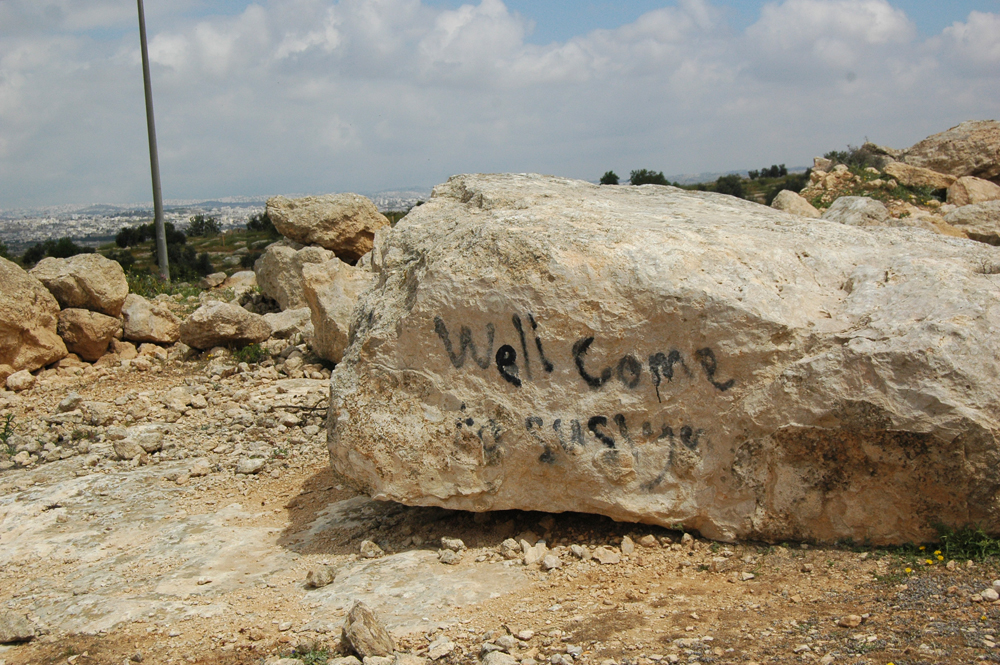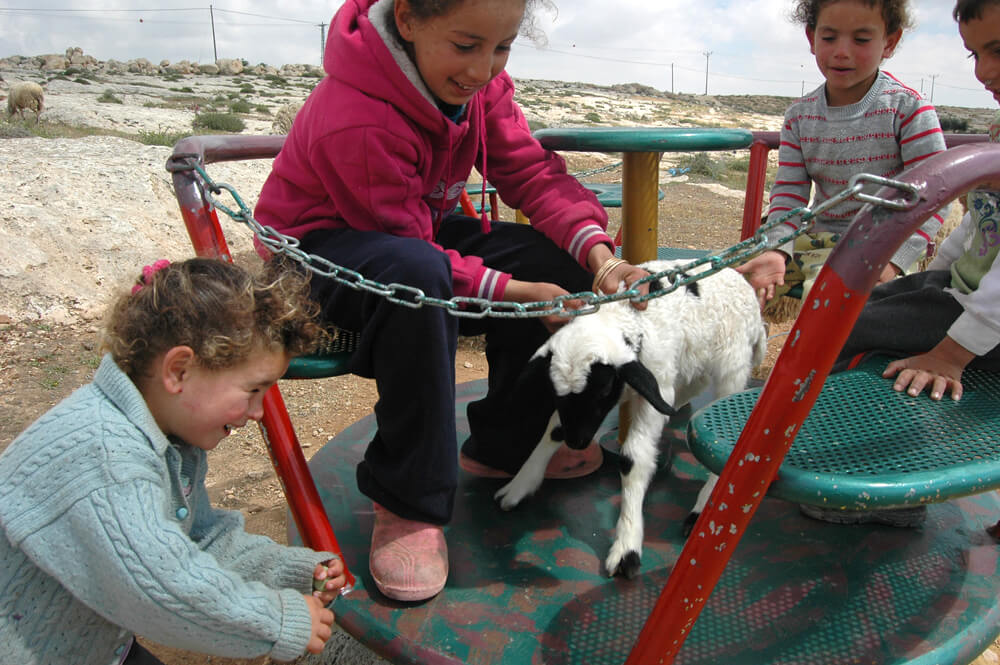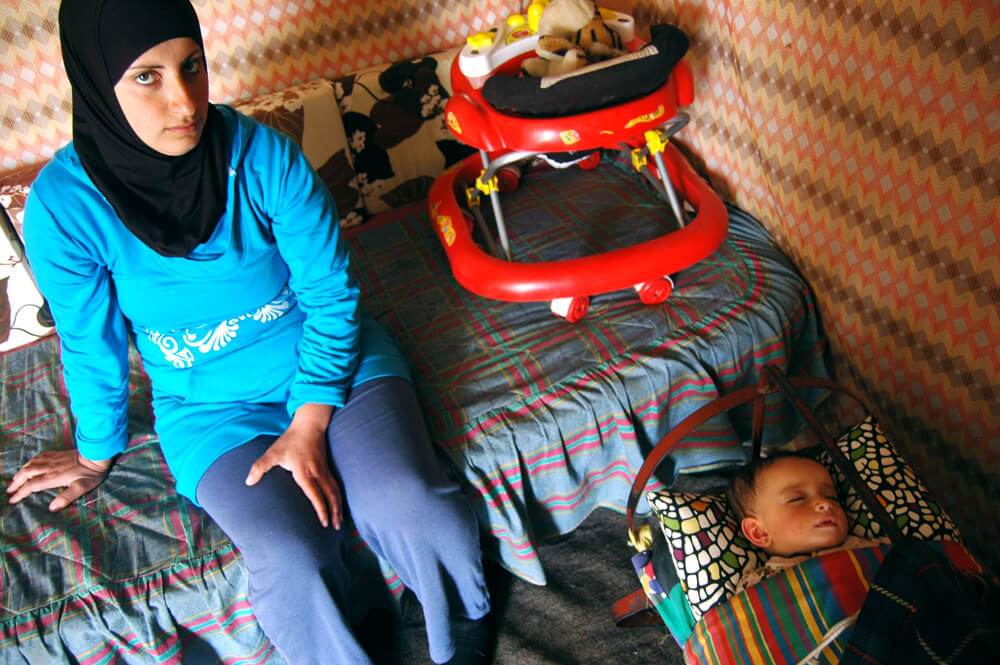A Tale of Two Susiyas or how a Palestinian village was destroyed under the banner of Israeli archaeology
 Tuesday, April 21, 2015 at 08:22PM
Tuesday, April 21, 2015 at 08:22PM http://mondoweiss.net/2015/04/palestinian-evicted-archeology
by Allison Deger 20 April 20115 Mondoweiss

Entrance to Susiya in the south Hebron hills, the West Bank. (Photo: Allison Deger)
Hiam al-Nawaja dreams to live in what she calls a “normal house.” The 23-year old mother of three small children and sheepherder manages in a cinder block frame insulated with a tarp. The interior is no larger than a generous two-door garage. Her modest home is typical in Susiya, a pastoral Palestinian village set in the rolling south Hebron Hills in the West Bank; all of the 45 families that live in Susiya reside under plastic and concrete.
Yet a few short decades ago Susiya’s residents had sturdy stone structures built over ancient caves on a hilltop one kilometer from where their town stands today. The former location, “old Susiya,” is close enough that al-Nawaja can see bulldozed remains from her kitchen window. It was destroyed in 1986 when Israel dismantled the town’s mosque to uncover an ancient Jewish synagogue dating back to the sixth century. The day after I visited al-Nawaja, a Bar Mitzvah was held at the site.
Old Susiya is now administered by an Israeli settlement and has been converted into a tourist attraction named “Susya: Ancient Jewish town,” as the brochure states. (The i was dropped).
In this tale of two villages, Susiya and Susya, the Palestinian town is again facing relocation, and the archeological park is hoping to expand on that same piece of land.
Hiam al-Nawaja (L) and Dahlia al-Nawaja in their home, Susiya, the West Bank. (Photo: Allison Deger)
Until late March an injunction shielded Palestinian Susiya from further eviction. Then the state petitioned to remove all of the remaining structures, Hiam’s house included. It is expected a decision will be issued in writing later this month.
Israel wants to connect the archeological site to a residential settlement, also called Susya, that flanks the Palestinian town on the far side. The state argued they need to expand the preservation of historical Jewish sites underneath where the Palestinians now live. A representative for the Susya archeological park told Mondoweiss the expansion is not to continue archeological excavations, rather the land will be used for residential housing. Nonetheless, Susiya and Susya have become a shocking example of Palestinian displacement under the banner of Israeli archeology.
Living in close proximity to settlers had caused problems for Susiya. In 2008 a group of masked youths from the Israeli settlement beat al-Nawaja’s relatives with sticks. They broke the jaw and arm of one of her elderly family members. The incident was filmed on a camera distributed by the Israeli human rights group B’tselem and featured in a report by the BBC that same year.
Still daily life continues, even when facing a looming displacement.
“I want a good life for my children,” al-Nawaja said while sitting on a mattress in her living room. Her youngest, Dahlia, slept by her feet in a metal crib. Dahlia, along with all of the children in al-Nawaja’s village, was sick with a head cold when I visited in early April. Al-Nawaja then prepared tea using a filtration system to purify water that is carted in heaping tanks into Susyia. There are solar panels too. Though, they did not generate enough electricity to heat every room during the last, particularly snowy, winter.
Houses in Susiya. (Photo: Allison Deger)

Children play in Susiya. (Photo: Allison Deger)
These “tents,” as Hiam calls her house, are barred from connecting to water and electrical lines. All of the roads are rocky and unpaved. There is no trash removal. In legal terms, Susiya is called an “unrecognized village.” It falls under the Oslo-delineated Area C of the West Bank where Israel oversees all planning and construction, as well as security. Israel denies more than 95% of Palestinian requests to construct new homes in Area C and there are no Palestinian police in Susiya, instead the Israeli army patrols the region.
Yet loopholes in housing laws allowed Palestinians to reside in non-permanent structures, like al-Nawaja’s.
A five-minute walk east of Susiya, everything is new and shiny in the archeological park of Susya. Scented soaps and wines crafted in settlements are sold in a gift shop. The public restrooms are clean and connected to water pipes. Children play with clay and paint pictures in an arts and crafts gazebo. Tourists can have an interactive Talmudic period experience in excavated ritual Jewish baths and wells.
In 2010, Susya, the archeological park was designated a National Heritage Site, one of six Israeli destinations in the West Bank. With this status Susya enjoys funding from Israel’s Ministry of Foreign Affairs and many of the guides are 20-somethings subsidized by the state. Most of the year the archeological site is quiet. Israel’s Ministry of Foreign Affairs told me they do not track the number of visitors because the park is not a major attraction. But on holidays over 1,000 tourists come per day, said Nachshon Afik, 47, an attendant working in Susya on a hot spring day in early April. “Don’t forget that Susya is in the territories, so people are afraid to come,” he said, adding some think it is “like Gaza.”
“We can also do weddings. It’s really beautiful after 1,000 to 1,500 years to see a wedding here,” said Afik. Afik estimated around half of the visitors during the Passover holiday live in settlements in the West Bank. Many were American-Israelis, speaking in a mash-up of English and Hebrew.
A working village that was established 1,500 years ago as a Jewish town during the late Roman period is preserved inside of Susya. Stones are carved with the symbol of a menorah. One doorframe has a rectangle chiseled out in the upper right side, thought to be where a mezuzah once hung. Much is known about their daily life. Several stone olive presses were found in caves, along with shards of pottery and coins from the Hellenistic era. Another guide explained one olive press is still functional. When asked, the Palestinians in Susyia claimed they used the same machine before their expulsion.
The guides at archeological Susya do not give tourists any information about the town’s recent Palestinian history, nor did they explain that the original inhabitants were driven away to a field just beyond the park’s driveway. When asked where the Palestinian neighbors came from, the guides responded inconsistently.
“They are from Yatta [a nearby Palestinian city],” said a cheerful guide with strawberry-blond hair, costumed in the attire of ancient Jew. She told me Palestinians had only lived in Susiya for two years.
Afik had a different take. He said that the Palestinians did take shelter in the 1980s in archeological Susya, but only seasonally. A group of tourists overheard the debate on the origins of the Palestinian neighbors and joined in. One tourist knew that the Palestinians were expelled by Israel in order to excavate Susya. Daniel Eisenberg, a settler in Gush Etzion, said expelling the Palestinians in order to build the park was “terrible” and “ironic.” Another tourist shrugged his shoulders. “It happens everywhere.”
Mohammed al-Nawaja in Susiya, the West Bank. (Photo: Allison Deger)
Hiam al-Nawaja’s father-in-law, Mohammed Ahmed Nasser al-Nawaja, 70, said he was born in a cave in Susya that has become part of the excavation grounds. Her husband Nasser was born in the same cave in 1982.
“Now we live here like prisoners,” said Mohammed as he motioned to the settlements next door.
Palestinians from Susiya have tried to purchase an admission ticket to now archeological Susya a handful of times. They say they have been denied entry each time.
----------------------------------------------------------------------------------------------------------------------------------
 APJP |
APJP |  Post a Comment |
Post a Comment | 

